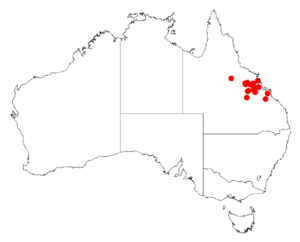Acacia fodinalis facts for kids
Quick facts for kids Acacia fodinalis |
|
|---|---|
| Scientific classification | |
| Genus: |
Acacia
|
| Species: |
fodinalis
|
 |
|
| Occurrence data from AVH | |
Acacia fodinalis is a special type of tree. It belongs to a large group of plants called Acacia, also known as wattles. This tree is found only in the northeastern parts of Australia.
What Does the Acacia fodinalis Look Like?
This Acacia tree can grow quite tall, up to 10 m (33 ft) high. Its younger branches are reddish and have sharp angles. They also feel a bit sticky because they have resin.
Like many Acacia species, this tree does not have true leaves. Instead, it has structures called phyllodes. These are flattened leaf stems that act like leaves. The phyllodes of Acacia fodinalis stay green all year round. They are slightly curved, like a sickle, and get narrower at both ends.
These phyllodes are smooth, meaning they have no hairs. They are usually between 8.5 to 13 cm (3.3 to 5.1 in) long and 8 to 15 mm (0.31 to 0.59 in) wide. You can see many thin lines, called nerves, running along them. Two or three of these lines are usually clearer than the others.
Flowers and Seed Pods
When the tree blooms, it produces simple flower clusters. These clusters are shaped like a cylinder and are somewhat open. They are 25 to 70 mm (0.98 to 2.76 in) long and covered in yellow flowers.
After the flowers, the tree grows seed pods. These pods are long and thin, and they are brown. They have bumps where the seeds are and are slightly squeezed between the seeds. The pods are straight, about 45 mm (1.8 in) long and 2.3 to 3 mm (0.091 to 0.118 in) wide. Their edges have yellow lines.
Inside the pods, the seeds are light brown and arranged lengthwise. Each seed is about 3.5 mm (0.14 in) long and 1.7 to 2 mm (0.067 to 0.079 in) wide. They have a yellow, cup-shaped part called an aril, which helps with seed dispersal.
Where Does the Acacia fodinalis Grow?
Acacia fodinalis is endemic to central eastern Queensland. This means it is found naturally only in this specific area of Australia. You can find it in the upper parts of the Isaac River area. It also grows in nearby parts of the Belyando River region.
This tree usually grows on floodplains and along riverbanks. It prefers sandy soils. It is often found in open woodlands where Eucalyptus trees grow. It commonly grows alongside a specific type of Eucalyptus tree called Eucalyptus crebra.

